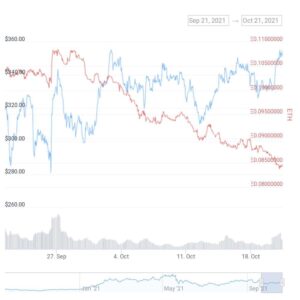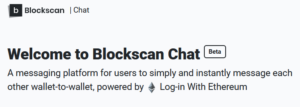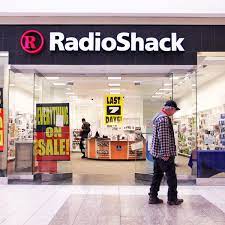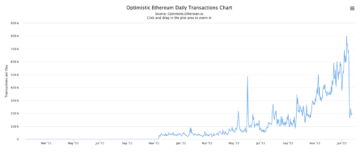Ethereum Scaling Solutions Surpass Mainnet By 48%
Activity on Layer 2 networks has surged to new all-time highs, with combined L2 activity beating out mainnet Ethereum transaction volume by 48% on Thursday.
More than 1.54M transactions were executed on Layer 2 networks in the past day, compared to 1.04M on Ethereum, according to Orbiter Finance. L2 transactions previously peaked at 1.52M on Feb. 22.
The data shows that Ethereum users are increasingly migrating onto Layer 2 scaling solutions, which offer faster and cheaper transactions compared to Ethereum’s mainnet.
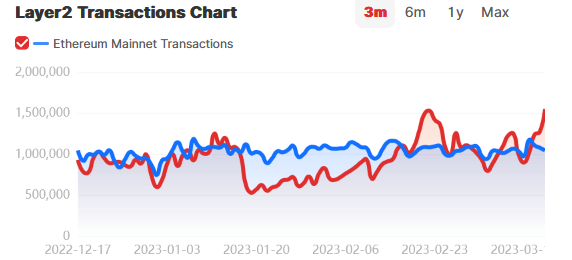
Arbitrum One, the leading Layer 2, beat out Ethereum’s volume alone with 1.08M transactions. Optimism ranked second with 267,288 transactions, followed by Arbitrum Nova with 52,070, and zkSync with 49,410.

Arbitrum To Airdrop Long-Awaited ARB Token On March 23
Layer 2 Network To Decentralize And Add Support For Layer 3 Blockchains
Ethereum fees have remained relatively low for the past nine months, generally averaging between $2 and $6 since mid-2022, according to BitInfoCharts. But fees abruptly tripled amid the chaos caused by the USDC stablecoin de-pegging over the weekend, highlighting Ethereum’s need for a robust Layer 2 ecosystem.
Average transaction fees trended between $20 and $60 at the peak of the bull market in Q4 2021.
Capacity Constraints
Nick Bishop, director of NotCentralised, a web3 venture studio, said that while Ethereum is excellent at providing security, it is also “capacity constrained.”
“L2s have a natural tailwind from rising DeFi usage,” Bishop continued. “As the usage of tokens expands into high volume, real-world ecosystems, higher throughput is essential.”
Daniel Bar, the founder of venture capital network Bitfwd Capital, said the spike in L2 activity marks a new era of L2-focused blockchain development.
“The maturation of the various L2s, particularly Arbitrum and Optimism, set a trajectory for multichain L2 ecosystems to flourish on their own,” Bar said. “We can expect this trend to grow exponentially in the next bull run as more users flood the products that are getting built on these L2s.”
Layer 2 Adoption
Layer 2 networks now secure $6.6B in total value locked (TVL), according to L2beat. That equates to 14% of overall DeFi TVL and 23% of Ethereum’s DeFi TVL, according to data from DeFi Llama.
The sector is dominated by Arbitrum and Optimism, which represent 86% of its TVL. Both are optimistic rollup networks. Rollups work by bundling together transactions on Layer 2, and then submitting them to the Ethereum mainnet for finalization.
Optimistic rollups were fast to gain market share because of their compatibility with the Ethereum Virtual Machine, Ethereum’s core smart contract engine. However, mainnet withdrawals are slow, requiring a 7-day delay because of the fraud prevention methods employed by optimistic rollups.
Competing With ZK Technology
Arbitrum and Optimism may soon face stiff competition from a new generation of EVM-compatible rollups secured by zero-knowledge proofs (zkEVMs). Proponents tip that zkEVMs will offer faster finality and enhanced security guarantees compared to optimistic solutions.
Polygon, Matter Labs, Scroll, and Consensys will each launch a mainnet zkEVM in the coming months, with Polygon’s zkEVM expected to arrive first on March 27.
Bishop expects the increasing adoption of Ethereum L2s will undermine the value proposition of low-cost EVM-compatible Layer 1 networks and force them to either “morph into L2s or die.”
“No chain has surpassed Ethereum in ecosystem breadth and flexibility of smart contract deployment,” he continued. “Ethereum will sink further down in the web3 tech stack to a foundational, secure set of rails on top of which L2, L3, and L4 iterations will flourish.”
- SEO Powered Content & PR Distribution. Get Amplified Today.
- Platoblockchain. Web3 Metaverse Intelligence. Knowledge Amplified. Access Here.
- Source: https://thedefiant.io/ethereum-l2-txs-surpass-mainnet/
- :is
- 1
- 2021
- 54M
- a
- abruptly
- According
- activity
- Adoption
- airdrop
- all-time highs
- alone
- Amid
- and
- arbitrum
- Arbitrum Nova
- ARE
- AS
- At
- averaging
- bar
- because
- between
- blockchain
- blockchains
- breadth
- built
- bull
- Bull Market
- Bull Run
- by
- CAN
- capital
- caused
- chain
- Chaos
- cheaper
- combined
- coming
- compared
- compatibility
- competition
- continued
- contract
- Core
- daily
- data
- day
- decentralize
- DeFi
- DeFi llama
- DeFi TVL
- delay
- deployment
- Development
- Die
- Director
- down
- each
- ecosystem
- Ecosystems
- either
- Engine
- enhanced
- equates
- Era
- essential
- ethereum
- ETHEREUM MAINNET
- ethereum virtual machine
- Ethereum's
- excellent
- expands
- expect
- expected
- expects
- exponentially
- Face
- FAST
- faster
- Feb
- Fees
- finality
- finance
- First
- Flexibility
- flood
- flourish
- followed
- For
- Force
- founder
- fraud
- FRAUD PREVENTION
- from
- further
- Gain
- generally
- generation
- getting
- Grow
- guarantees
- Have
- High
- higher
- highlighting
- Highs
- However
- HTML
- HTTPS
- in
- increasing
- increasingly
- IT
- iterations
- ITS
- l2
- l4
- launch
- layer
- Layer 2
- layer 2 scaling
- Layer 3
- leading
- Llama
- locked
- long-awaited
- Low
- low-cost
- machine
- mainnet
- March
- Market
- methods
- months
- more
- multichain
- Natural
- Need
- network
- networks
- New
- next
- of
- offer
- on
- ONE
- Optimism
- Optimistic
- Optimistic Rollups
- overall
- own
- particularly
- past
- Peak
- peaked
- plato
- Plato Data Intelligence
- PlatoData
- Polygon’s
- Prevention
- previously
- Products
- proofs
- proposition
- providing
- rails
- ranked
- real world
- record
- relatively
- remained
- represent
- rising
- robust
- rollup
- Rollups
- Run
- Said
- scaling
- Second
- sector
- secure
- Secured
- security
- set
- Share
- Shows
- since
- slow
- smart
- smart contract
- Soars
- Solutions
- Soon
- Source
- spike
- stablecoin
- stack
- studio
- support
- Surged
- surpass
- surpassed
- Tailwind
- tech
- that
- The
- their
- Them
- These
- throughput
- tip
- to
- together
- token
- Tokens
- top
- Total
- total value locked
- trajectory
- transaction
- Transaction Fees
- Transactions
- Trend
- TVL
- Undermine
- Usage
- users
- value
- various
- venture
- venture capital
- Virtual
- virtual machine
- volume
- Web3
- which
- while
- will
- with
- Withdrawals
- Work
- zephyrnet
- zero-knowledge
- zero-knowledge proofs
- ZK
- zkEVM
- zkSync

